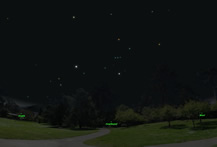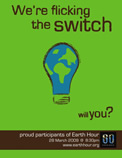The results of the Let There Be Night experiment are in. See /results.html.
To see what's happening at individual PHM schools, see the district map at /phm.html. More LTBN news, events, satellite predictions, and website additions are at /whatsnew.html.
Let There Be Night is a community-wide science experiment to measure how much of the night sky is already lost. As part of the 2008-2009 Penn-Harris-Madison (PHM) curriculum, all students in grades 3-8 will be introduced to dark-sky issues at the PHM Planetarium and during regular clasroom instruction.

 Every night March14-28, 2009, the students will observe Orion from their back yards (right) and judge how many stars they can see within the constellation. They will compare their backyard observations of Orion with six star charts (left) that having increasing numbers of visible stars. In class the students will report their Magnitude Chart number, which we will collectively forward to Globe at Night, a Cornerstone Project of the 2009 International Year of Astronomy celebration. With guidance from the National Optical Astronomy Observatory in Tucson, AZ, teachers will lead all students in analyzing the data and discussing the side effects of outdoor lighting technology.
Every night March14-28, 2009, the students will observe Orion from their back yards (right) and judge how many stars they can see within the constellation. They will compare their backyard observations of Orion with six star charts (left) that having increasing numbers of visible stars. In class the students will report their Magnitude Chart number, which we will collectively forward to Globe at Night, a Cornerstone Project of the 2009 International Year of Astronomy celebration. With guidance from the National Optical Astronomy Observatory in Tucson, AZ, teachers will lead all students in analyzing the data and discussing the side effects of outdoor lighting technology.
Hear the Podcast: Let There Be Night is featured on the "Gosh Dim It All!" podcast, which was broadcast by the New Media Working Group of the International Year of Astronomy 2009. You can also find it and daily astronomy podcasts at 365 Days of Astronomy. Scroll down to (or find in the Archives) the podcast for Sunday, January 18, 2009.
A Student Leadership Team from each school will take concurrent readings with three Sky Quality Meters (SQM) every night for two weeks from their respective schools yards. The teams will make a 3D model of the results out of LEGO blocks and present the combined findings from all schools and suggest solutions for the school district at the May 11, 2009, School Board meeting.
If you go to school or live outside of PHM, you can still participate in the public star hunt by sending your observations directly to Globe at Night. You can download family packets (in English and in several other languages) from the Globe at Night Parent Information Page. There you can preview their Orion star charts, which you will compare to the view outside your backyard.
Links:
- Six star charts showing Orion with different levels of light pollution. The greater the light pollution (e.g., Magnitude Chart #1) the fewer the stars.
- Globe at Night
Orion star count resources support LTBN and 2009 International Year of Astronomy - Interactive Orion "Slider"-
Compare magnitude numbers to your view of Orion by "sliding" through skies with different levels of light pollution. - I Touch Map
Easily find latitude and longitude to four decimal points for your viewing site. - Galileo's Vision
See the key observations that convinced Galileo that the old model no longer worked. - Earth Hour encourages businesses, governments, and residents to turn off lights March 28, 8:30-9:30 PM; (see the Earth Hour web page for families and teachers)
- PHM Planetarium Clear Sky Clock
Weather prediction for PHM area confirms good viewing times
- Astronomical Twilight
Calendar shows when the sun has set far enough (astronomical twilight) that sky is at its darkest and sun is not contributing any light to the night
- PHM Planetarium & Air/Space Museum
Before or after your visit, explore online some of the national treasures and exhibits on display in the PHM Planetarium - Spaceweather
Current happenings and photographs of astronomy stuff you can see, like aurorae, comets, noctilucent clouds, and sunspots - Heavens-Above
Find out when the International Space Station and other satellites glide over your location. Then go outside and wave to the passing astronauts.
- YMCA AstroCamp
Spend a week stargazing with telescopes at a Michigan summer camp
- Observing Highlights & Sky Chart
See what's hapening in the night sky this week
- Local student projects:
- Sorry Starry Night compares sky before and after retail development
- Students investigate lighting issues and share findings with classmates
- Dark Sky Team compares nightly SQM values at astronomical twilight (coming soon)
- Ideas for student-directed projects (from Night Vision)
- Ideas for local projects (from Let There Be Night)
- Siemens We Can Change the World Challenge offers opportunity for small student teams.
Globe at Night: Students will view sky charts at and send their results to www.globe.gov/GaN/.
Recommended Reading
The PHM Educational Foundation has purchased one copy of these two books for each school's library.
- Sky Lore from Planet Earth: stories from around the world...Orion from local author/illustrator Dayle Brown. PTO's that have Meet the Author programs or similar visits by authors can contact Dayle Brown directly to arrange a visit by her.
- There Once Was a Sky Full of Stars, written by Bob Crelin and illustrated by Amie Ziner.
For more depth into outdoor issues, Chuck Bueter recommends:
- Let There Be Night, Testimony on Behalf of the Dark, edited by Paul Bogard. This collection of letters and short essays written in 2008 about dark sky issues is unrelated to our project of the same name, though it parallels our interests and goals.
- Ecological Consequences of Artificial Night Lighting, edited by Travis Longcore and Catherine Rich, explains the impact of outdoor lighting as revealed by scientific research. The book expands on essays that are summarized in their paper Ecological Light Pollution.
- Silent Cry for Dark Skies, courtesy of Universe in the Classroom.
Contact us at: 
 New 2009 Earth Hour Poster (left) is available for participating Earth Hour sites.
New 2009 Earth Hour Poster (left) is available for participating Earth Hour sites.
Scientific Method
Galileo launched the scientific method. We will try to continue those ideals with our application of the scientific method in Let There Be Night.
- Define the question/problem.
By how much have we degraded the night sky from its natural state? How can PHM and the community lessen its impact on the night? - Gather information (observe) and resources.
Planetarium visit; www.LetThereBeNight.com; Let There Be Night DVD; recommended books; Orion star charts; Sky Quality Meters. - Form hypothesis.
Local outdoor lights have quantifiably brightened the sky throughout the boundaries of PHM. PHM and the community can take several identifiable steps to improve its outdoor lighting. - Perform experiment and collect data.
All students observe Orion and contribute their data to the 2009 Globe at Night star count while small teams quantify sky glow from each PHM school with hand-held meters. - Analyze data.
During the last two weeks of March 2009, students will share their findings in class and on a school boundaries map. Online or other digital resources will map the district-wide results, which will be shared and compared with the global community. - Interpret data and draw conclusions.
Teachers will guide discussions about the experience; about emerging trends from the data; and about how we prioritize the tradeoffs of outdoor lighting technology. The combined school teams will meet to make recommendations on how PHM can save money and energy while lessening its footprint on the night sky. - Publish results.
May 11th PHM School Board meeting; national publications; websites.
Let There Be Night Student Leadership Team
Let There Be Night (LTBN) seeks one team of 5 students from each PHM school. Teachers will make recommendations to the school principal, who will name the final candidates. One teacher from each building will oversee the team operation.
Each Leadership Team will manage its school’s three hand-held Sky Quality Meters (SQMs), which are available for independent science fair projects. During the Globe at Night (GaN) campaign, March 14-28, the team will take SQM readings from the same spot every night on school grounds, cloudy or clear. Not all team members need to be together these two weeks, but amongst themselves the team must have coverage for every night. They will also observe the constellation Orion and estimate light pollution by comparing the number of stars they see from school with several Orion star charts of varying brightness. Observations must be after astronomical twilight, which is approximately 9:30 p.m. in late March.
The teams will meet initially for a thorough introduction to outdoor lighting issues and LTBN. They will help manage the data within their respective schools during Globe at Night's Orion star count. The team will correlate the sky glow observed with the naked eye by their classmates with sky glow measured by the meter. They will meet again to build a model that conveys the results of the community-wide investigation. And they will present the results and any recommendations to the PHM School Board on May 11, 2009.
Name the Next Mars Rover
For something completely different, name the next Mars Rover in this NASA contest: http://marsrovername.jpl.nasa.gov/.

